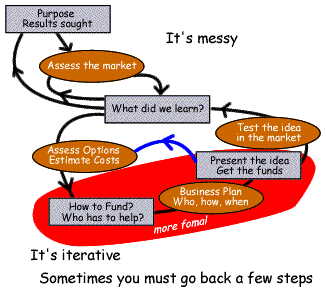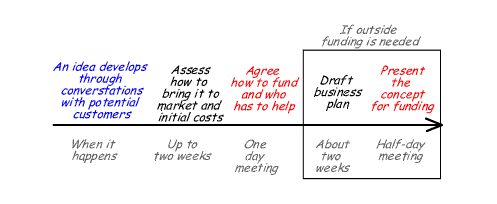In small firms, entrepreneurs top-down
or a bottom-up effort
 Bottom-up
planners and entrepreneurs jump at the opportunity. They
adapt quickly to changes in the market. Bottom-up
planners and entrepreneurs jump at the opportunity. They
adapt quickly to changes in the market.
First, I'll discuss the process in a small firm or a
start-up entrepreneur.
Then I'll discuss a bottom-up approach in a larger firm
with an entrepreneurial approach is needed to sell an
idea up to senior executives.
The process begins to shift when the team decides to
focus mostly on high margin customers.
Overview
Key words
Risk taker, innovator, visionary, change agent, champion,
intuition, passion — words that describe people
who systematically pursue opportunities. They sell quality,
value, simplier, smarter, better price to their customers.
Characteristics
Strategies emerge from their work, once they are successful
in the market. The team of key players is smaller; funding
the initial work is challenging. Commitment is paramount — faith
in the idea and the team. Learning is rapid, and lessons
learned quickly incorporated. Focus, focus, focus and
more focus. These folks are not romantic heroes. This
is hard work and the key effort/measure is growing market
share.
Strategic Planning Process
This strategy formulation process is less formal, sometimes
its fast; the team works closely together frequently.
Consensus evolves from dozens of conversations. I'll
describe the process from two perspectives: inside a
small firm and inside a large, complex organization.
An Idea Emerges
 It's
exciting and starts informally as other buy-in and a
coalition develops. It's
exciting and starts informally as other buy-in and a
coalition develops.
Define Your Purpose
Overtime, a few people in many conversations identify
the purpose and a team forms.
Assess the market
They interact with potential customers to assess the
market.
What did we learn?
Over dinners, lunches, office meetings, socially, by
email, they discuss what they learned and an idea emerges.
Assess the options?
An idea evolves into product or service. The strategic
planning team considers options on how to proceed and
the initial startup costs.
Where Do We Get the Funding
At some point, the strategic planning coalition needs
start-up funding. These meetings are more formal - you
now have to formulate the strategy.
How to get funding? Who helps?
The agenda is to identify funding sources and who needs
to be influenced to support the funding?
Draft the business plan
To this point, a cocktail napkin may have been enough
documentation. Now, a business plan must be prepared
that will educate the reader about the concept and convince
them to give you their money.
Present it to potential funders
Most of the time, before someone will give you their
money, they want to meet you and "see" what
you have to say. These presentations must
be solid and convincing. Who needs to be there? Where?
How long?
Test If It Works
You bring the product or service to market — the
strategy is in place. Now less conceptual work, more
focus on getting it done.
Demonstrate it
A key step in strategy formulation is a simple demonstration
of the product to a test market roll-out, before you'll
get more money, folks need to see your customers like
you concept.
What did we learn?
You are almost guaranteed that you be adapting your
ideas as soon as you show it to potential customers.
Make
adjustments
You reassess, consider your options and costs, and could
go through the steps again.
Small Firm and Entrepreneur
Timelines
In a small firm, the process I just described goes faster.
Folks involved
A small core team - keep it small until it is proven
in the market place. Time to market is more important
than hundreds of meetings to build consensus.
Timeline

 Scenarios Scenarios |
|
Bottom-up
Inside a Large Firm  |
|